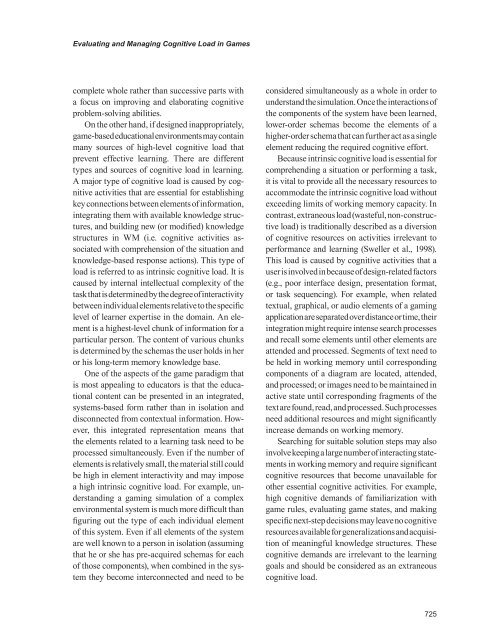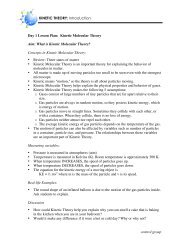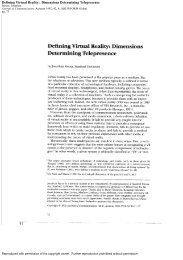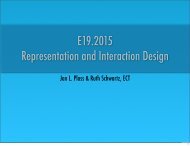Evaluating and managing cognitive load in educational games
Evaluating and managing cognitive load in educational games
Evaluating and managing cognitive load in educational games
Create successful ePaper yourself
Turn your PDF publications into a flip-book with our unique Google optimized e-Paper software.
<strong>Evaluat<strong>in</strong>g</strong> <strong>and</strong> Manag<strong>in</strong>g Cognitive Load <strong>in</strong> Games<br />
complete whole rather than successive parts with<br />
a focus on improv<strong>in</strong>g <strong>and</strong> elaborat<strong>in</strong>g <strong>cognitive</strong><br />
problem-solv<strong>in</strong>g abilities.<br />
On the other h<strong>and</strong>, if designed <strong>in</strong>appropriately,<br />
game-based <strong>educational</strong> environments may conta<strong>in</strong><br />
many sources of high-level <strong>cognitive</strong> <strong>load</strong> that<br />
prevent effective learn<strong>in</strong>g. There are different<br />
types <strong>and</strong> sources of <strong>cognitive</strong> <strong>load</strong> <strong>in</strong> learn<strong>in</strong>g.<br />
A major type of <strong>cognitive</strong> <strong>load</strong> is caused by <strong>cognitive</strong><br />
activities that are essential for establish<strong>in</strong>g<br />
key connections between elements of <strong>in</strong>formation,<br />
<strong>in</strong>tegrat<strong>in</strong>g them with available knowledge structures,<br />
<strong>and</strong> build<strong>in</strong>g new (or modified) knowledge<br />
structures <strong>in</strong> WM (i.e. <strong>cognitive</strong> activities associated<br />
with comprehension of the situation <strong>and</strong><br />
knowledge-based response actions). This type of<br />
<strong>load</strong> is referred to as <strong>in</strong>tr<strong>in</strong>sic <strong>cognitive</strong> <strong>load</strong>. It is<br />
caused by <strong>in</strong>ternal <strong>in</strong>tellectual complexity of the<br />
task that is determ<strong>in</strong>ed by the degree of <strong>in</strong>teractivity<br />
between <strong>in</strong>dividual elements relative to the specific<br />
level of learner expertise <strong>in</strong> the doma<strong>in</strong>. An element<br />
is a highest-level chunk of <strong>in</strong>formation for a<br />
particular person. The content of various chunks<br />
is determ<strong>in</strong>ed by the schemas the user holds <strong>in</strong> her<br />
or his long-term memory knowledge base.<br />
One of the aspects of the game paradigm that<br />
is most appeal<strong>in</strong>g to educators is that the <strong>educational</strong><br />
content can be presented <strong>in</strong> an <strong>in</strong>tegrated,<br />
systems-based form rather than <strong>in</strong> isolation <strong>and</strong><br />
disconnected from contextual <strong>in</strong>formation. However,<br />
this <strong>in</strong>tegrated representation means that<br />
the elements related to a learn<strong>in</strong>g task need to be<br />
processed simultaneously. Even if the number of<br />
elements is relatively small, the material still could<br />
be high <strong>in</strong> element <strong>in</strong>teractivity <strong>and</strong> may impose<br />
a high <strong>in</strong>tr<strong>in</strong>sic <strong>cognitive</strong> <strong>load</strong>. For example, underst<strong>and</strong><strong>in</strong>g<br />
a gam<strong>in</strong>g simulation of a complex<br />
environmental system is much more difficult than<br />
figur<strong>in</strong>g out the type of each <strong>in</strong>dividual element<br />
of this system. Even if all elements of the system<br />
are well known to a person <strong>in</strong> isolation (assum<strong>in</strong>g<br />
that he or she has pre-acquired schemas for each<br />
of those components), when comb<strong>in</strong>ed <strong>in</strong> the system<br />
they become <strong>in</strong>terconnected <strong>and</strong> need to be<br />
considered simultaneously as a whole <strong>in</strong> order to<br />
underst<strong>and</strong> the simulation. Once the <strong>in</strong>teractions of<br />
the components of the system have been learned,<br />
lower-order schemas become the elements of a<br />
higher-order schema that can further act as a s<strong>in</strong>gle<br />
element reduc<strong>in</strong>g the required <strong>cognitive</strong> effort.<br />
Because <strong>in</strong>tr<strong>in</strong>sic <strong>cognitive</strong> <strong>load</strong> is essential for<br />
comprehend<strong>in</strong>g a situation or perform<strong>in</strong>g a task,<br />
it is vital to provide all the necessary resources to<br />
accommodate the <strong>in</strong>tr<strong>in</strong>sic <strong>cognitive</strong> <strong>load</strong> without<br />
exceed<strong>in</strong>g limits of work<strong>in</strong>g memory capacity. In<br />
contrast, extraneous <strong>load</strong> (wasteful, non-constructive<br />
<strong>load</strong>) is traditionally described as a diversion<br />
of <strong>cognitive</strong> resources on activities irrelevant to<br />
performance <strong>and</strong> learn<strong>in</strong>g (Sweller et al., 1998).<br />
This <strong>load</strong> is caused by <strong>cognitive</strong> activities that a<br />
user is <strong>in</strong>volved <strong>in</strong> because of design-related factors<br />
(e.g., poor <strong>in</strong>terface design, presentation format,<br />
or task sequenc<strong>in</strong>g). For example, when related<br />
textual, graphical, or audio elements of a gam<strong>in</strong>g<br />
application are separated over distance or time, their<br />
<strong>in</strong>tegration might require <strong>in</strong>tense search processes<br />
<strong>and</strong> recall some elements until other elements are<br />
attended <strong>and</strong> processed. Segments of text need to<br />
be held <strong>in</strong> work<strong>in</strong>g memory until correspond<strong>in</strong>g<br />
components of a diagram are located, attended,<br />
<strong>and</strong> processed; or images need to be ma<strong>in</strong>ta<strong>in</strong>ed <strong>in</strong><br />
active state until correspond<strong>in</strong>g fragments of the<br />
text are found, read, <strong>and</strong> processed. Such processes<br />
need additional resources <strong>and</strong> might significantly<br />
<strong>in</strong>crease dem<strong>and</strong>s on work<strong>in</strong>g memory.<br />
Search<strong>in</strong>g for suitable solution steps may also<br />
<strong>in</strong>volve keep<strong>in</strong>g a large number of <strong>in</strong>teract<strong>in</strong>g statements<br />
<strong>in</strong> work<strong>in</strong>g memory <strong>and</strong> require significant<br />
<strong>cognitive</strong> resources that become unavailable for<br />
other essential <strong>cognitive</strong> activities. For example,<br />
high <strong>cognitive</strong> dem<strong>and</strong>s of familiarization with<br />
game rules, evaluat<strong>in</strong>g game states, <strong>and</strong> mak<strong>in</strong>g<br />
specific next-step decisions may leave no <strong>cognitive</strong><br />
resources available for generalizations <strong>and</strong> acquisition<br />
of mean<strong>in</strong>gful knowledge structures. These<br />
<strong>cognitive</strong> dem<strong>and</strong>s are irrelevant to the learn<strong>in</strong>g<br />
goals <strong>and</strong> should be considered as an extraneous<br />
<strong>cognitive</strong> <strong>load</strong>.<br />
725








